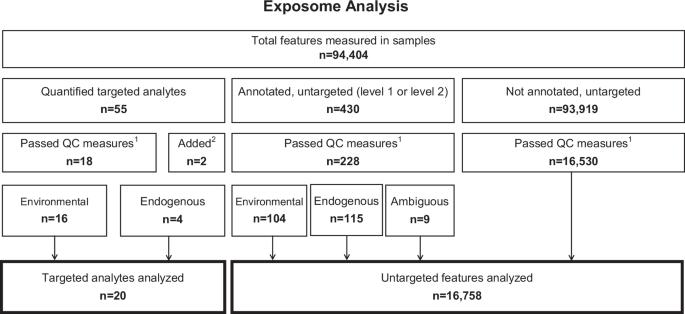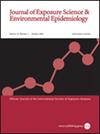Chemical exposomics in biobanked plasma samples and associations with breast cancer risk factors
IF 4.7
3区 医学
Q2 ENVIRONMENTAL SCIENCES
Journal of Exposure Science and Environmental Epidemiology
Pub Date : 2024-12-06
DOI:10.1038/s41370-024-00736-0
引用次数: 0
Abstract
The chemical exposome includes exposure to numerous environmental and endogenous molecules, many of which have been linked to reproductive outcomes due to their endocrine-disrupting properties. As several breast cancer risk factors, including age and parity, are related to reproduction, it is imperative to investigate the interplay between such factors and the chemical exposome prior to conducting large scale exposome-based breast cancer studies. This pilot study aimed to provide an overview of the chemical exposome in plasma samples from healthy women and identify associations between environmental exposures and three risk factors for breast cancer: age, parity, and age at menarche. Plasma samples (n = 161), were selected based on reproductive history from 100 women participating in the Northern Sweden Health and Disease Study, between 1987 and 2006. Samples were analyzed by liquid chromatography high-resolution mass spectrometry (LC-HRMS) for 77 priority target analytes including contaminants and hormones, with simultaneous untargeted profiling of the chemical exposome and metabolome. Linear mixed effects models were applied to test associations between risk factors and chemical levels. Fifty-five target analytes were detected in at least one individual and over 94,000 untargeted features were detected across all samples. Among untargeted features, 430 could be annotated and were broadly classified as environmental (246), endogenous (167) or ambiguous (17). Applying mixed effect models to features detected in at least 70% of the samples (16,778), we found seven targeted analytes (including caffeine and various per- and poly-fluoroalkyl substances) and 38 untargeted features, positively associated with age. The directionality of these associations reversed for parity, decreasing with increasing births. Seven separate targeted analytes were associated with age at menarche. This study demonstrates how a comprehensive chemical exposome approach can be used to inform future research prioritization regarding associations between known and unknown substances, reproduction, and breast cancer risk.

生物库血浆样本中的化学暴露组学及其与乳腺癌危险因素的关系。
背景:化学暴露包括暴露于许多环境和内源性分子,其中许多由于其内分泌干扰特性而与生殖结果有关。由于一些乳腺癌风险因素,包括年龄和胎次,都与生殖有关,因此在进行大规模的基于暴露体的乳腺癌研究之前,有必要调查这些因素与化学暴露体之间的相互作用。目的:本初步研究旨在概述健康妇女血浆样本中的化学物质暴露,并确定环境暴露与乳腺癌三个危险因素(年龄、胎次和初潮年龄)之间的关系。材料和方法:根据1987年至2006年间参加瑞典北部健康与疾病研究的100名妇女的生殖史选择血浆样本(n = 161)。采用液相色谱-高分辨率质谱法(LC-HRMS)对样品进行了77种优先目标分析,包括污染物和激素,同时进行了化学暴露体和代谢组的非靶向分析。采用线性混合效应模型来检验危险因素与化学物质水平之间的关系。结果:在至少一个个体中检测到55种目标分析物,在所有样本中检测到超过94,000种非目标特征。在非目标特征中,430个可以标注,大致分为环境特征(246个)、内生特征(167个)和模糊特征(17个)。将混合效应模型应用于至少70%的样本(16,778)中检测到的特征,我们发现了7种目标分析物(包括咖啡因和各种单氟烷基和多氟烷基物质)和38种非目标特征,它们与年龄呈正相关。这些关联的方向性与胎次相反,随着出生数的增加而下降。七个单独的目标分析与月经初潮的年龄有关。意义:本研究表明,综合化学暴露方法可用于告知未来关于已知和未知物质、生殖和乳腺癌风险之间关系的研究优先级。影响说明:这项研究说明了长期储存的血液样本的化学暴露组学如何为发现化学暴露及其与人类疾病的潜在联系,特别是与生殖和乳腺癌风险因素有关的疾病,提供了有价值的见解。
本文章由计算机程序翻译,如有差异,请以英文原文为准。
求助全文
约1分钟内获得全文
求助全文
来源期刊
CiteScore
8.90
自引率
6.70%
发文量
93
审稿时长
3 months
期刊介绍:
Journal of Exposure Science and Environmental Epidemiology (JESEE) aims to be the premier and authoritative source of information on advances in exposure science for professionals in a wide range of environmental and public health disciplines.
JESEE publishes original peer-reviewed research presenting significant advances in exposure science and exposure analysis, including development and application of the latest technologies for measuring exposures, and innovative computational approaches for translating novel data streams to characterize and predict exposures. The types of papers published in the research section of JESEE are original research articles, translation studies, and correspondence. Reported results should further understanding of the relationship between environmental exposure and human health, describe evaluated novel exposure science tools, or demonstrate potential of exposure science to enable decisions and actions that promote and protect human health.

 求助内容:
求助内容: 应助结果提醒方式:
应助结果提醒方式:


